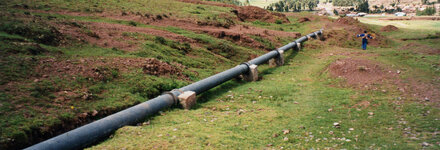1. I am designing a RC support (see attached) for 600 dia. ductile iron carrying sewage water from pumping station. Mostly pipe is aligned upward on embankment at slope 8%. I understand that for before casting concrete foundation, we would need to place the pipe on temporary support. Can anybody advise considering the shape of footing and reinforcement in upright portion of pipe support how this foundation can be casted and what precautions to be taken?
2. The pressure values for ductile iron pipes on this website https://www.abtersteel.com/ductile-iron-pipe/ may be higher in actual use. I don’t know if I can exceed the standard pressure values and what dangers will arise if I do:
K Classes (K7, K8, K9): Defined by ISO 2531, these denote wall thickness relative to diameter (e.g., K9 is thicker than K7). K9, the most common, handles pressures up to 50 bar (725 psi) with safety factors, ideal for urban water supply.
C Classes (C25, C30, C40): Per EN 545/598, these specify allowable operating pressure (e.g., C25 = 25 bar, or 363 psi). They’re tailored for specific applications, with C40 suited for high-pressure trunk lines.
2. The pressure values for ductile iron pipes on this website https://www.abtersteel.com/ductile-iron-pipe/ may be higher in actual use. I don’t know if I can exceed the standard pressure values and what dangers will arise if I do:
K Classes (K7, K8, K9): Defined by ISO 2531, these denote wall thickness relative to diameter (e.g., K9 is thicker than K7). K9, the most common, handles pressures up to 50 bar (725 psi) with safety factors, ideal for urban water supply.
C Classes (C25, C30, C40): Per EN 545/598, these specify allowable operating pressure (e.g., C25 = 25 bar, or 363 psi). They’re tailored for specific applications, with C40 suited for high-pressure trunk lines.

